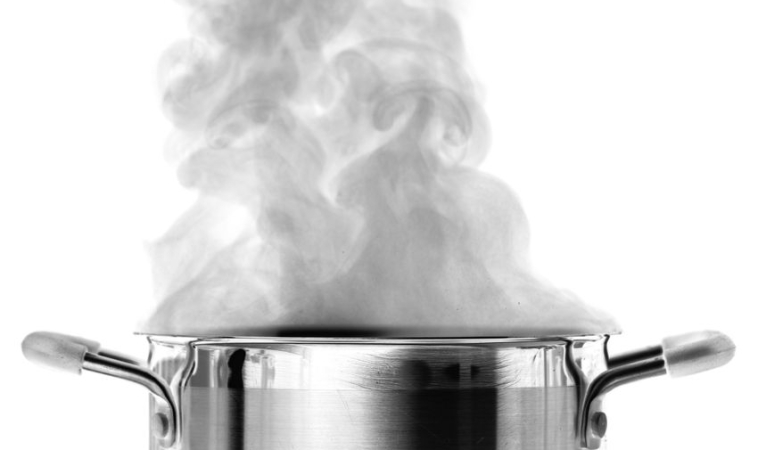Recently, as I was standing and heating water on the stovetop for a cup of tea, I recalled watching a friend of mine heating water for tea in the microwave. She’s had cancer and as she popped each of our cups into “the box” and pushed the button I quietly wondered about the safety and effects on our health of microwaving. I personally have never cared for microwave ovens and have several times declined them as gifts. But as I waited for my stovetop water to boil I wondered what the current findings might be on the safety and healthiness of microwaving water.
At “Browbeat”, a “culture blog”, whereas boiling water for a cup of tea in a kettle is described as raising water temperature by convection current to a uniform 212〫(“a rolling boil”), microwaving a cup of water is described as “shoot[ing] tiny waves into the liquid at random locations”, producing a cup of hot but not necessarily boiling, and until stirred, not typically uniformly heated water. Boiling water is preferred for making tea in cases where the desired medicinal or chemical compounds are more readily soluble in hotter water. Caffeine, for example, is said to be “extremely soluble at 212〫but significantly less so at 145-175〫” a temperature range better suited to green tea according to the blogger. Thus, for the blogger, boiling water vs. microwaving was a matter of desired chemical content of the beverage.¹
The microwaving quality of unevenly heating is supported by a NASA science experiment in which scientists were testing whether water might be produced on the lunar surface by microwaving lunar dust. Microwaving dust from the permafrost layer, containing ice crystals, yielded water vapor which they condensed to yield liquid water. Simultaneously they demonstrated that microwaving proceeds unevenly, contoured around the microwave’s point of impact in wavelike displacement patterns.² Their illustration resembled a topographical map showing curving, colored layers bending back away from the furthest reach of the microwave. Like a rose thorn piercing a gardener’s green thumb in slow motion, the sharpest or hottest impact at the tip transferring in layers to surrounding areas.
But beyond the physical characteristics of uniformity and compound solubility, does one’s method of heating water influence one’s health? What answers does a Mind/Body approach to the question yield?
Experimentation with Water
Perhaps you have heard of the experiments on water and ice crystals by Masaru Emoto, the Japanese researcher who was curious to know what differences might be observed from freezing different samples of water from different sources. He reported, “At first, we strenuously observed crystals of tap water, river water, and lake water. From the tap water we could not get any beautiful crystals. We could not get any beautiful ones from rivers and lakes near big cities, either. However, from the water from rivers and lakes where water is kept pristine from development, we could observe beautiful crystals with each one having its own uniqueness.”³
He continued experimenting. In a second phase he and his researchers applied various external conditions to water samples from the a single “pure” source, doubly distilled water used in (Japanese) hospitals. The external influences were various forms of music, words of emotion written on paper placed around the sample and prayer, for example. Of those experiments he wrote, “The result was that we always observed beautiful crystals after giving good words, playing good music, and showing, playing, or offering pure prayer to water. On the other hand, we observed disfigured crystals in the opposite situation. Moreover, we never observed identical crystals.”³
Of course, these conclusions were challenged. However, he was extremely scrupulous in his technique and reporting and he published four books of photographs and one explaining his technique, all of which were worldwide best sellers.
Masaru Emoto’s experiments and photos of water crystal structures suggest that the structural nature of water is influenced by its environment including thoughts and feelings; less attractive patterns arose when water was exposed to harsher, rougher thoughts and feelings, whereas more attractive patterns resulted when water was exposed to kinder, more positively oriented thoughts and feelings. Thus, he demonstrates a “super conductor” capacity of water, to manifest consciousness. Many of these images are viewable online by googling Masaru Emoto’s name.
Another researcher, Jan Wicherink, takes the concept of the structure of water and its super conducting nature a step further. Traditional “alternative” medicine cultures talk about a universal life force animating all life. In Traditional Chinese Medicine, for example, this force is known as “Chi”, in Ayurvedic Medicine as “Prana”. Wicherink writes, “Recent discoveries in biology now show that water inside a biological cell is highly structured” and concludes that resonance between these cellular structures and cosmic energy is “the secret” of all biological life.⁴
Microwaving your water for a hot cup of tea vs. boiling it on the stovetop? Viewed physically, the two methods produce different temperatures and different chemical content. The Mind/Body view on the question seems to suggest that for both safety and health practicing the art of positive intentions with each use of water is a very simple yet powerful tool for health. Bless your water and be blessed!
 Katy Nelson, ND, (Bastyr ’94), with an office since 1997 in Michigan’s rural Upper Peninsula on the shores of beautiful Lake Superior, promotes our Nature devoted profession through consultation, writing and mentoring. She is joined by Bastyr grad, former mentoree and Pediatric specialist, Alicia Smith Dambeck, LAc CH (also ad locum in St. Paul with Amy Johnson Grass, ND). Since 2011, Dr. Katy has been ad locum herself in SW FL for family matters.
Katy Nelson, ND, (Bastyr ’94), with an office since 1997 in Michigan’s rural Upper Peninsula on the shores of beautiful Lake Superior, promotes our Nature devoted profession through consultation, writing and mentoring. She is joined by Bastyr grad, former mentoree and Pediatric specialist, Alicia Smith Dambeck, LAc CH (also ad locum in St. Paul with Amy Johnson Grass, ND). Since 2011, Dr. Katy has been ad locum herself in SW FL for family matters.
References:
- Arumugam, N. (2013, June 4). Why Does Microwaving Water Result in Such Lousy Tea? Retrieved January 23, 2015, from http://www.slate.com/blogs/browbeat/2013/06/04/microwaving_water_for_tea_why_are_the_results_so_lousy.html
- Coulter, D. (2009, October 7). Microwaving Water from Moondust – NASA Science. Retrieved January 23, 2015, from http://science.nasa.gov/science-news/science-at-nasa/2009/07oct_microwave/
- Emoto, M. (2010). What is the Photograph of Frozen Water Crystals? Retrieved January 23, 2015, from http://www.masaru-emoto.net/english/water-crystal.html
- Wicherink, J. (2006). How Water Accumulates Orgone. Retrieved January 23, 2015, from http://www.soulsofdistortion.nl/water4.html
















